Kurt Meyer writes a weekly column for the Nora Springs – Rockford Register, where this essay first appeared. He serves as chair of the executive committee (the equivalent of board chair) of Americans for Democratic Action, America’s most experienced liberal organization.
It’s human nature to regard your home community as special, distinctive, or unique in one way or another. I’ve always seen my rural community in this light, although some claims to fame are rather small.
For example, I surge with pride knowing a former governor, Clinton Clauson, attended the same rural school that I did, although his Otranto pupil days were four decades before mine. Okay, it wasn’t in the same facility, but it was the same school system. I should add, he was governor of Maine and died in office. Still, a surge of pride.
Another instance: The stream thirty yards from our house is the one brook in Iowa home to the “least darter.” I quote an article by John Olson, published in American Currents in 2015: “A small tributary of Otter Creek (locally known as Poor Creek) in the upper Cedar River basin, is the only known Iowa location where the least darter still occurs.”
In 1978, our friend Tom, in north Iowa to attend our wedding, found this rare darter. With a PhD in Ecology from the University of California, Davis, Tom is now vice president and dean, Division of Agricultural Sciences & Natural Resources, Oklahoma State University.
These paragraphs are prelude to yet another local claim. Northern Mitchell County is home to “perhaps the largest known population of Baltimore checkerspot butterflies,” according to the website for Nelson Paradise Wildlife Area, two miles from our home.
Whoa, broad statement. Seeking verification, I called my neighbor Chelsea, a naturalist employed by the Mitchell County Conservation Board, fearful that she might fudge a bit, by emphasizing “perhaps” more than “the largest known population.”
Much to my joy, she didn’t. Coupled with more Baltimore checkerspots at the Hamlin Garland Wildlife Area, a half-dozen miles away, I live near two Baltimore checkerspot havens, the significance heightened by the fact that these butterflies are categorized as “threatened” in Iowa, with only eighteen documented populations in the state. (Pity the least darter, found at only one site.)
According to Insects of Iowa, a terrific website created and maintained by a dedicated citizen,
This striking butterfly has black wings with rows of white rectangles, spots, and crescents, bordered with red-orange half-moons. Brick-red spots occur near the upper forewing. (It’s) very rare across the northeastern quarter of the state, where it is limited to high-quality fens, open woodland seeps, and marshes. Larvae consume the relatively infrequent wildflower white turtlehead, (which) occurs on almost all 160 remaining fens in northeastern Iowa.
Side note: the Baltimore checkerspot is named for George Calvert, the first Lord Baltimore; its colors and patterns are similar to those on his heraldic shield and on Maryland’s state flag.
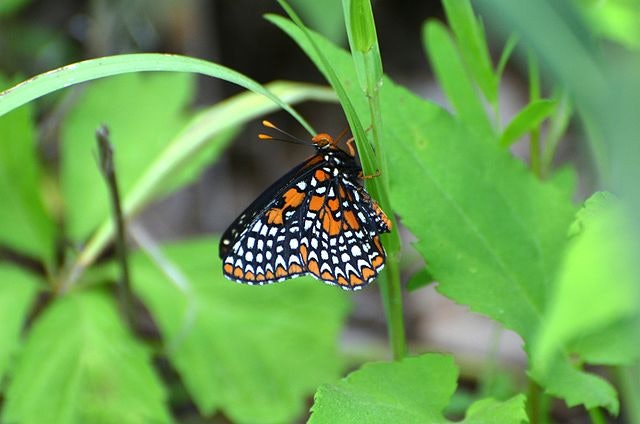
Baltimore checkerspot photographed by Andy Reago & Chrissy McClarren, available via Wikimedia Commons
These butterflies thrive locally because wildflowers called “turtleheads” thrive locally. Just as monarchs require milkweed (“host-specific” is the term Chelsea used), Baltimore checkerspot in their larvae state require white turtleheads. And white turtleheads fare best in a fen.
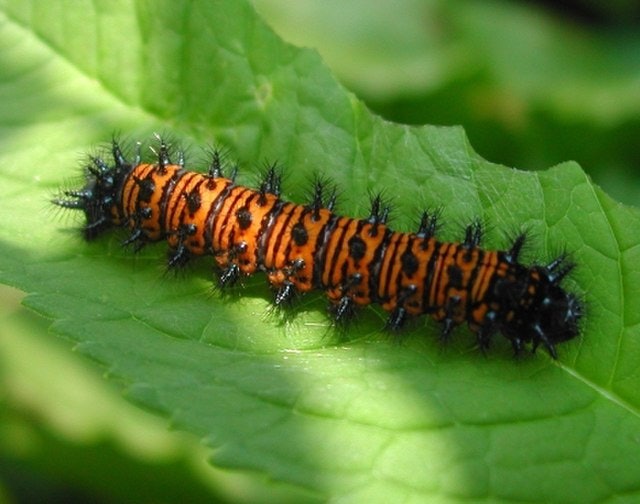
Larva of Baltimore checkerspot, from the Pennsylvania Department of Conservation and Natural Resources – Forestry Archive, available via Wikimedia Commons
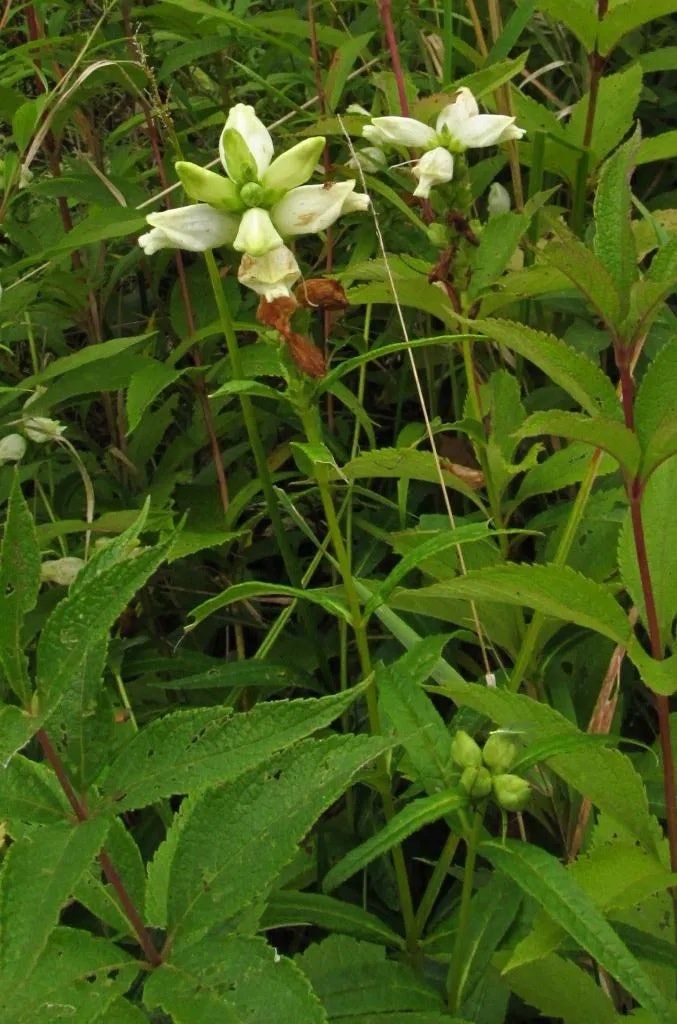
White turtlehead plants photographed by Laura Belin in 2014
So then, what’s a fen? Fens are among the rarest wetlands in Iowa, fed by groundwater rather than by rain or run-off. As water flows underground it dissolves carbonate minerals and becomes alkaline. In Iowa, more than 225 plant species are associated with fens. A single fen could contain as many as 75 species, including several dozen plants considered endangered, threatened, or of special concern.
Wetlands once covered six million Iowa acres; today, fewer than five percent of these original wetlands remain. Fens — a specific kind of wetland – are even more rare, with approximately 300 known fens scattered throughout the state. Among these 300 locations are Nelson Paradise Wildlife Area and Hamlin Garland Wildlife Area, both under the stewardship of the County Conservation Board.
Knowing my neighbor, the late Helen Nelson, the original Paradise donor, and “knowing” Hamlin Garland (I’m currently president of the Hamlin Garland Society) only enhances my surge of local pride.
Long may nature flourish in North Iowa… complete with rare darters, unusual fens, uncommon flowers, and striking butterflies.
Top photo of Baltimore checkerspot by Judy Gallagher taken at Big Meadows, Shenandoah National Park in Virginia, available via Wikimedia Commons.
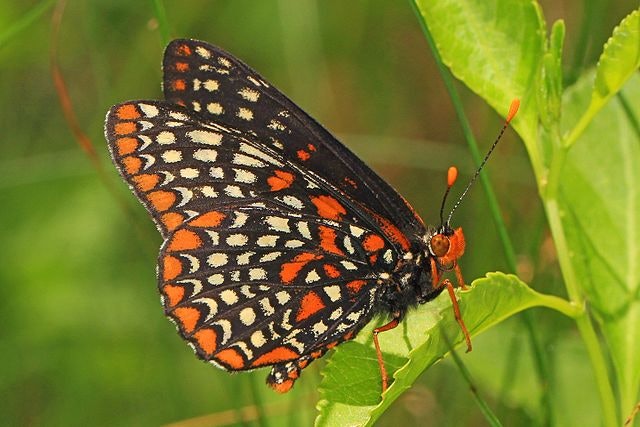
Bonus photo: Baltimore checkerspot with wings spread out on a swamp milkweed plant. Photo by Joshua Mayer taken at Wisconsin State Natural Area #627, available via Flickr or Wikimedia Commons.
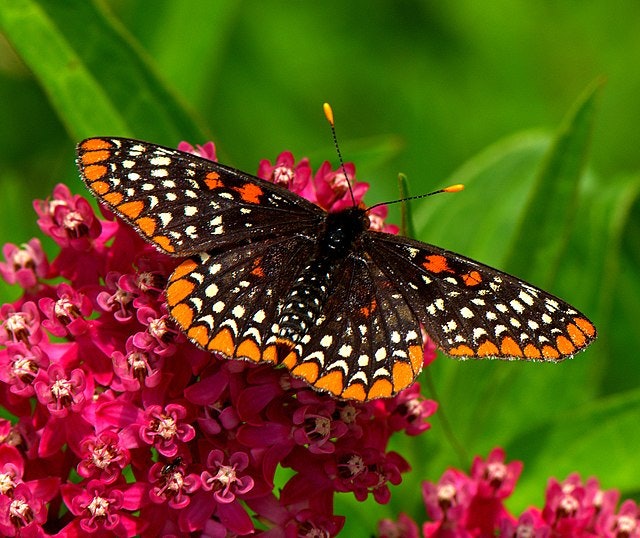

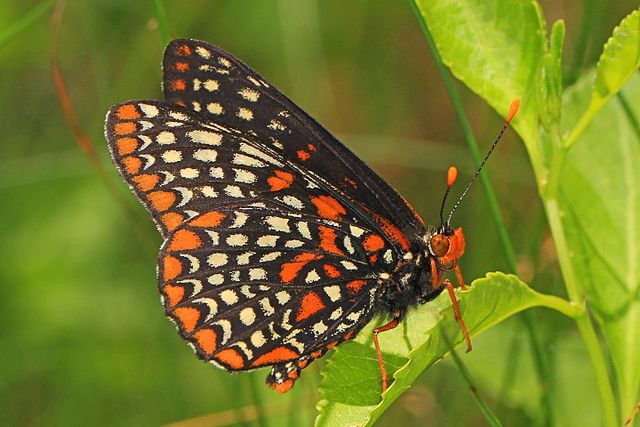
1 Comment
I am much, much, MUCH more impressed and pleased by these biotic claims to fame...
…than I would be about more conventional local Iowa fame claims. Thank you for sharing, Kurt Meyer!
Congratulations to your community, and long may the least darter swim and the Baltimore checkerspot fly! I looked up the least darter and it is as beautiful, in its own way, as the butterfly. Both are so small and perfect.
I am reminded of a very wise old saying. It should be taught to every student in every K-12 school in Iowa, to help our children grow up to be more enlightened than their elders are today.
“Unless we allow the land to produce beauty as well as food, it will, in the end, produce neither.”
PrairieFan Tue 20 Dec 8:57 PM